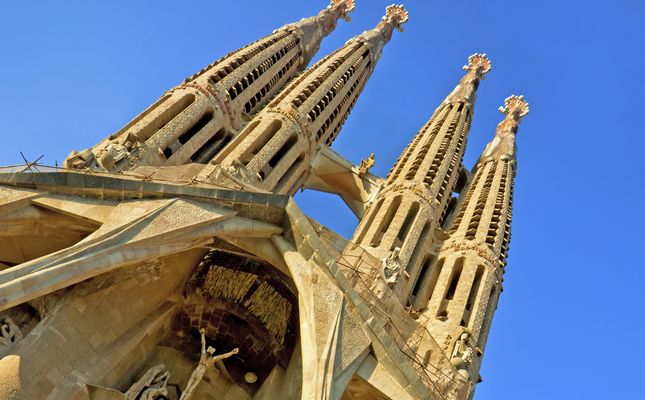[fshow photosetid=72157629781875518]
Being an avid appreciator of all things architectural, I was excited after months of planning to finally arrive in Barcelona, home to Antoni Gaudí, a remarkable architect and artist whose work I had only admired online prior to the trip. I had, of course, been inspired by the works of Salvador Dalí (another Catalan great) through my travels over the years. His collection is scattered worldwide from a museum in Florida to a boutique hotel in Taipei. As a confirmation of the sights that awaited in the Spanish city, I learned that amongst those who defended the Gaudí name when his reputation took a beating post-mortem was none other than Dalí himself. Two greats don’t make a wrong, so my hopes were high.
The Gaudí – Güell connection
I had long assumed that Gaudí’s conspicuous designs led to the birth of the word ‘gaudy’, but a little research disproved my theory as the word has been around centuries longer than the artist. Several of Gaudí’s works do carry the name Güell – Colonia Güell, Parque Güell, Palacio Güell – all of which are included in a selection of 7 buildings collectively recognized by UNESCO World Heritage under ‘Works of Antoni Gaudí’. Senior Güell was actually an industrialist who first came to know of Gaudí when he saw one of the artist’s works displayed at the Paris World Exhibition in 1878 – an appreciation that inspired Güell to commission many projects, becoming the architect’s main patron throughout their long friendship and working relationship.
Park Güell
Not only was Güell a patron to Gaudí, he was also considered a benefactor to the city of Barcelona. To find out why, my first stop was to the visit Park Güell, the gift he gave to the city that earned him the honorary title. The land where the park now sits was originally sectioned off into 60 plots designed as a utopian estate for the rich. But the development never took off, and just as well, as now the recreational park is open for visitors to enjoy the master’s handiwork, as well as offering stunning panoramas across Barcelona. The entrance has somewhat of a Disney feel to it, with a double staircase leading upwards, flanked by colored tiles with castle wall-like features. Colorful mosaic artworks are scattered around the park, with dragon sculptures, sun depictions on the ceiling, and the long meandering serpent bench that snakes around itself, forming seating pockets to rest achy feet. Colonnaded pathways lean heavily inwards, and I had to fight the natural urge to lean with the lopsided arches. An on-site museum was once the home of Gaudí and now houses a collection of his quirky art.
Sagrada Família
Sagrada Família ranks with the most visited destinations in the whole of Spain. It is, for lack of a better word, unconventional, and even unpleasant at first sight, especially with construction going on and cranes crowding the spires (Gaudí took over the project in 1883, the year after construction commenced, but it’s still unfinished). The Nativity Façade was intended by Gaudí to set the mood for the others, with liberal use of symbolism speckled into the architecture – reading up on them prior to visiting added great depth to the appreciation. Inside, the high vaults and intricate columns showcase Gaudí’s appreciation of geometry and high level mathematics, even more impressive considering he never put his designs on paper, but rather built 3D models before a single brick was laid on most of his projects. The interior is decked out in mind blowing details – maximalism at its best – with hints of gothic revival, Catalan modernism, and a strong influence from nature that uses natural light and the framing of space to exemplify details.
Casa Batlló
Casa Batlló, a former home for a wealthy aristocrat, is another of Gaudí’s creations that has to be visited to understand how a riot of colors and myriad shapes can come together into one contorted masterpiece of biomorphism. Whenever I look back on the hundred of photos taken during the trip to Spain, I might even go as far to say if you only had time to visit one site in Barcelona (heaven forbid), this may be it. From the outside, its most eye catching feature is the roof, which looks like a psychedelic colored dragon, sunning itself atop the narrow building. Oval windows framed in skeletal structures peep out from the facade made of 330 colourful ceramic discs and glass fragments, every one of which was reportedly directed into precise positioning by Gaudí from street level. The central well that runs down the building is covered in different shades of blue as a salute to the Mediterranean, and there are intricacies throughout the entire interior, from the stunning staircase to a curiously blue window. The 18,50 Euros for the entrance fee, inclusive of an audio guide, is well worth it, and comes with a host of ‘did you know’ facts that add to the wonder of the Gaudí’s creative mind.
It’s a challenge to describe Antoni Gaudí’s mind bending designs scattered in and around Barcelona. Going by the nickname “God’s Architect”, these are 5 of Gaudí’s works in Barcelona that should be on every traveller’s to-see list:
- Casa Batlló: http://www.casabatllo.es
- Park Güell: http://parkguell.es
- Sagrada Família: http://sagradafamilia.cat
- Casa Vicens: http://casavicens.es
- Casa Milà

